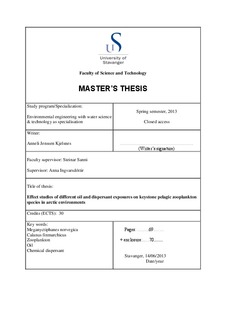| dc.description.abstract | Expanding petroleum activities into northern marine areas have resulted in need for tools that specify Arctic specific characteristics when assessing environmental risks for these regions. In order to estimate the environmental impact of mechanically or chemically dispersed oil, on marine populations in sensitive northern environments, laboratory studies need to be developed. Such studies would be useful fir risk assessments and modelling potential effects of oil related pollution. The overall objective of the thesis was to establish an exposure study that would be useful for estimation of the effects of oil in ice or blowout scenarios on northern marine keystone organisms. Further, some basic parameters of growth and moulting of the Northern krill from the Stavanger area was established under different experimental conditions. A moult pre-study tested three different feeding regimes (Artemia nauplii + commercial shrimo larvae feed (EZ larvae), Thalassiosira algae paste + EZ Larvae and starved) studied over a period of two months. The length measurements recorded for moults and frozen animals only differentiated between the starved group and the fed treatments, and overall negative INC values at the end in all treatments were most likely caused by maintenance procedures. The study showed that the fed groups kept their moulting rhythm while the starved group did not.
The CFS exposure experiment conducted on M. norvegica revealed no significant difference between the Control (no oil), Low (0.54 mg/l) or Medium (1.6 mg/l) treatments of mechanically dispersed crude oil exposures in the moults frequency or animal lengths or weights. However, all individuals in the High (4.9 mg/l) exposure group died before first sampling, and all in Medium died before the second sampling. Still, the Low treatment was persistently lower than the Control in all measured parameters and visual observation of the moults revealed potential bacterial infection on oil exposed individuals. The second exposure experiment assessed the toxicity of crude oil (0.1%) and oil treated with chemical dispersant Corexit 9500A (2% of oil concentration), resulting in a Control, Oil and O+D treatment. Behavioural observations, respiration rates and moulting were recorded for the Northern krill, and egg production and mortality recordings for C. finmarchicus monitored over a period of fourteen days. The behavioural observations illustrated a significant difference both between and within the three treatments over the course of the experiment. The majority of the krill in the Oil and O+D treatments appeared hyperactive at the start of exposure, though later the activity level in a large fraction of the krill in the exposed treatments decreased to what appeared to be narcosis. The behavioural observations were highly informative, and preceded the increase in mortality among the krill. Respiration rates at the early and late experimental days correlated to the krill behavioural observations at the corresponding dates, with high oxygen consumption in the exposed treatments at first, then lower consumption towards the end. A significant difference was found between the Control and the exposed groups at the end of the experiment, but not between the Oil and O+D treatments. Moult recordings revealed no significant difference between the treatments. Yet, the animals in the oil and oil + dispersant appeared to have a slightly postpone moulting compared to the Control. The egg production rates in C. finmarchicus did not reveal a significant difference between the treatments. However, a reduction egg production in the oil exposed treatments (even more so in O+D) compared to the Control was observed. The morality recordings of C. finmarchicus clearly differentiated in both experimental days, treatments and the combination of the two. There were close to five times higher mortality in the O+D treatment than in the Control, and approximately 2 times higher mortality in the Oil than seen in the Control at the fourteenth and final day of exposure. As a result, caution should be taken when considering the direct application of dispersant in natural environments, even though it has the advantage of rapidly removing crude oil. These results may provide knowledge and tools to prepare for environmental management of future operations in sensitive boreal and sub-arctic environments. | no_NO |
